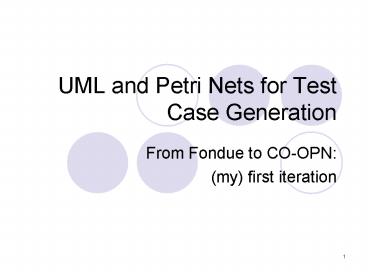UML and Petri Nets for Test Case Generation - PowerPoint PPT Presentation
1 / 20
Title:
UML and Petri Nets for Test Case Generation
Description:
Fondue (cont. ... The Fondue process can be outlined by a UML class diagram showing usage ... Transform Fondue pre and post-conditions using OCL ... – PowerPoint PPT presentation
Number of Views:129
Avg rating:3.0/5.0
Title: UML and Petri Nets for Test Case Generation
1
UML and Petri Nets for Test Case Generation
- From Fondue to CO-OPN
- (my) first iteration
2
Outline
- Users viewpoint the 4 steps for test generation
- The Model - Fondue approach
- Deriving test cases and applying criteria
- Implementation testing
- Test results
- Developers viewpoint - OO Petri Nets to enable
state space exploration - The Intermediate format
- Steps to Transformation
- .
- Current work
- Next chapters
3
Users viewpoint the 4 steps in the test
generation
- Step 1 The Model
4
Step 1 The model
- UML (Fondue specification)
- Software development process for reactive systems
- Purpose is to produce description of
- the problem domain
- The functional requirements of the system
- What it provides
- Concept Model Defines the static structure of
the information in the system - Behavior Model Defines the Input and Output
communication of the system - Uses UML for notation (parts of different UML
diagrams) - e.g Specification (models)
- Concept Model ? Class Diagram
- Environment Model ? Collaboration Diagram
- Protocol Model ? State Diagram
- Operation Model ?(OCL)
5
Step 1 The Model (cont.)
- Fondue (cont.)
- Describes operations by operation schemas which
specify operations by pre- and post conditions
using OCL - Effect of the operation on an abstract state
representation of the system and by events sent
to the outside world - The change of state resulting from an operation's
execution is described in terms of objects,
attributes and association links, which conform
to the constraints imposed by the analysis class
model of the respective system. Restricted form
of state diagrams is used to describe sequencing
of system operations. - The Fondue process can be outlined by a UML class
diagram showing usage dependencies between the
models
6
Step 1 The Model (cont.)
- Fondue - ebanking example
- Environment Model (messages from the user)
ltltsystemgtgt eBanking
loginUserName loginPasswd loginChallenge createPay
ment giveDetailsBeneficiary modifyPaiment deletePa
yment
User
7
Step 1 The Model (cont.)
- Fondue - ebanking example
- Environment Model (messages from the system)
ltltsystemgtgt eBanking
sendChallengeNumber errorUserName errorPasswd erro
rChallenge errorUserBlocked errorPaymentCreation e
rrorPaymentModification
User
8
Step 1 The Model (cont.)
- Fondue - ebanking example
- Concept Model
ltltsystemgtgt eBanking
1
position
table
0.. 1
1
ltltIdgtgt
0..
0.. 1
HasSessionId
User
9
The full picture
Model
ltTgt
Tests
Driver Mapping
Application
Mapping rules
Criteria
Implementation Interface
Production
Oracle Assumptions
Observation
Test Results
10
Developers viewpoint - OO Petri Nets to enable
state space exploration
- Steps to transformation and the Internal format
11
Steps to Transformation
- Goal from Fondue to CO-OPN
- OCL translation
- Fondue Operational Model
- Transformation (represents OO formalisms)
- Object states and attributes
- Management of object creation and destruction
- Typing references polymorphism
- DataTypes generators and operators
12
Step 1 Read/Load Fondue Model
- Export Fondue Model to XMI
- Using Together Fondue export tool
- Generates XMI Fondue Model
- Load Fondue Model
- Fondue Metal Model described in terms of MOF
- MOF M3 level -gt Meta-MetaModel
- Use of MDR
- Implementation of MOF
- Can be managed programmatically using JMI
- Parse it with JMI
- Java Metadata Interface
- Rules for generating metamodel-specific Java API
- Defines a set of reflective interfaces that can
be used similarly to the metamodel-specific Java
API without prior knowledge of the metamodel
13
Step 1 Read/Load Fondue Model
Fondue Model
Export, Load and Parse
XMI FondueMM
Load by MDR
Parse Using JMI
?
FondueMM MOF desc
Intermediate Format
14
Step 2 The Environment model
- Environment model ? 1 CO-OPN Context
- Operations ? methods of the context
- Output messages ? Gates
input
output
15
Step 3 Concept model
- 1 Class ? 1 CO-OPN Class
- Name ? Name
- Attributes ? Places
- Access methods put, get, read
- Method put_a(x) a y -gt a x
- Gate get_a(x) a x -gt a x
- Gate read_a(x)a x -gt a x
- Associations as classes
- With source and target values
- Instatioation of AADT Bag
- For each class
put
put
get
16
Step 3 Concept model
- 1 Class ? 1 CO-OPN Class
- Name ? Name
- Attributes ? Places
- Access methods put, get, read
- Method put_a(x) a y -gt a x
- Gate get_a(x) a x -gt a x
- Gate read_a(x)a x -gt a x
!
Questions regarding this diagram
- Why dont we have a Method get?
- Only Gates with get/read functions
- How can we see the difference between
- Gates and Methods
17
Step 4 Operation model
- Transform Fondue pre and post-conditions using
OCL - Operation Schemas ? (synchronization rules,
algebraic equations)
Not fully understood -( Further investigation
needed
18
Current work
- Whats done
- Fondue exportation
- XMI FondueMM
- Read/Load Fondue Module
- Using a particular MDR implementation and
- Fondue MOF description
- Parse
- Using JMI
- Environment model
- Concept model
19
Next chapters
- Finish the application simulated eBanking
application - Understand OCL and in particular Fondue Operation
Schemas - Prepare a first iteration for the translation
process - To understand the full picture regarding relation
between Fondue internal structure and CO-OPN
20
The end
Questions... Comments































